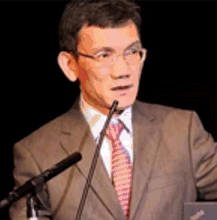 Does the embryo freezing method have an impact on the birth weight of newborns from thawed embryo transfer cycles? Prof Zhou and others from the Sun Yat-sen University Hospital in Guangzhou, China presented their finding as a poster (G17-1069) at ESHRE 2017 in Geneva. Their conclusion from a Large Scale Retrospective Study in Two Centers was that vitrification of cleavage stage embryos resulted in lower fetal birth weight compared to a slow-freezing method.
Does the embryo freezing method have an impact on the birth weight of newborns from thawed embryo transfer cycles? Prof Zhou and others from the Sun Yat-sen University Hospital in Guangzhou, China presented their finding as a poster (G17-1069) at ESHRE 2017 in Geneva. Their conclusion from a Large Scale Retrospective Study in Two Centers was that vitrification of cleavage stage embryos resulted in lower fetal birth weight compared to a slow-freezing method.
Prof Canquan Zhou (pictured here), Dr Fang Gu and others from the centres for reproductive medicines at the First Affiliated Hospital and the Jiangmen Central Hospital at Sun Yat-sen University in Guangzhou, China studied whether fetal birth weights were lower in a vitrified group than those in a slow-freezing group. A retrospective, two-center study was performed for 1797 singleton neonates born alive over 28 weeks of gestation after cleavage thawed embryo transfer was carried out in two large reproductive medical centers in South China, using the period January 2012 to December 2016. While vitrification was assumed superior to slow-freezing techniques regarding embryo survival rate and live birth rate the question of whether the vitrification cryopreservation method would affect fetal growth is still controversial.
In the study neonatal outcomes including gestational age, gender and birth weight were analysed with 1407 singletons born from vitrified group and 390 from slow-freezing embryo transfer. Although absolute birth weight was comparable between two groups, the adjusted birth weight controlled for gestational age and gender in the vitrified group was lower than in the slow-freezing group; the rate of macrosomia was significantly decreased in babies from vitrified embryo transfer. The gestational age and the rate of preterm birth were comparable between the two groups. The sex ratio, rate of small for gestational age and large for gestational age , as well as the rate of low birth weight were all comparable between the two cryopreservation methods. Linear regression analysis demonstrated that maternal weight, gestational age, embryo freezing method and infant gender were significantly related to neonatal birth weight.
This was a Retrospective study so the authors point out that research on long-term effects on the health of children are needed. Nevertheless they suggest vitrified embryo transfer seems to give rise to a decrease in neonatal birth weight, suggesting the potential epigenetic changes resulted from the high concentration of cryoprotectants should be carefully considered.
Prof Zhou uses a Planer cryogenic slow rate controllable freezer and the work was funded by the Chinese Ministry of Health through their public welfare scientific research special fund.
Poster (G17-1069) from ESHRE 2017


